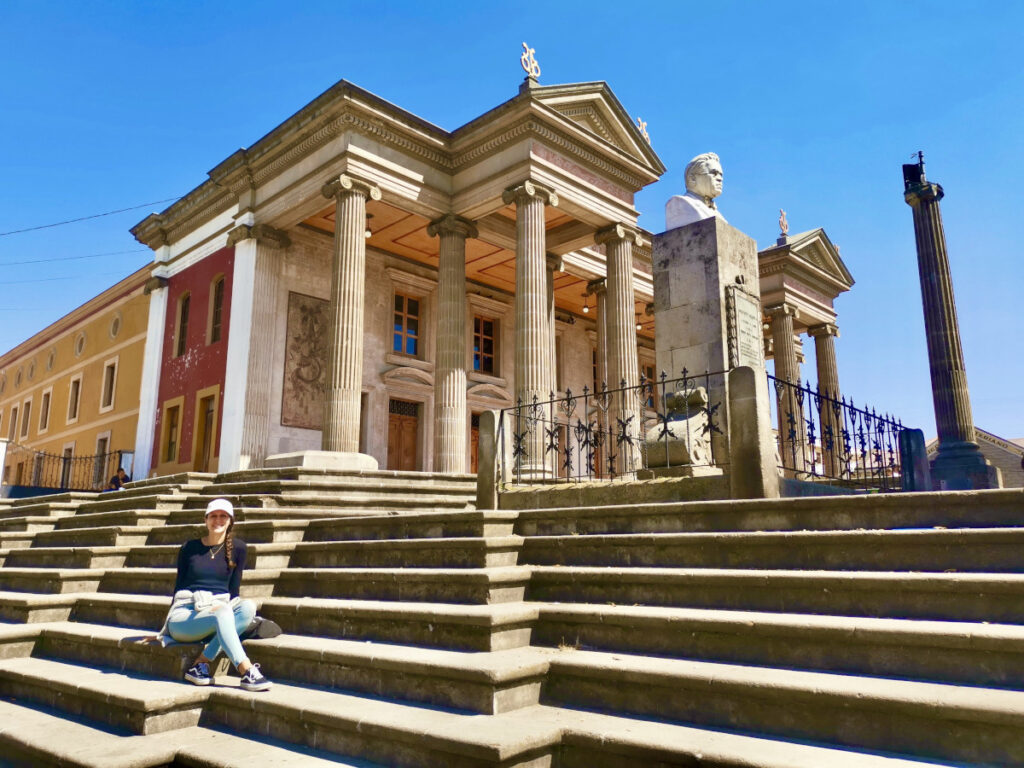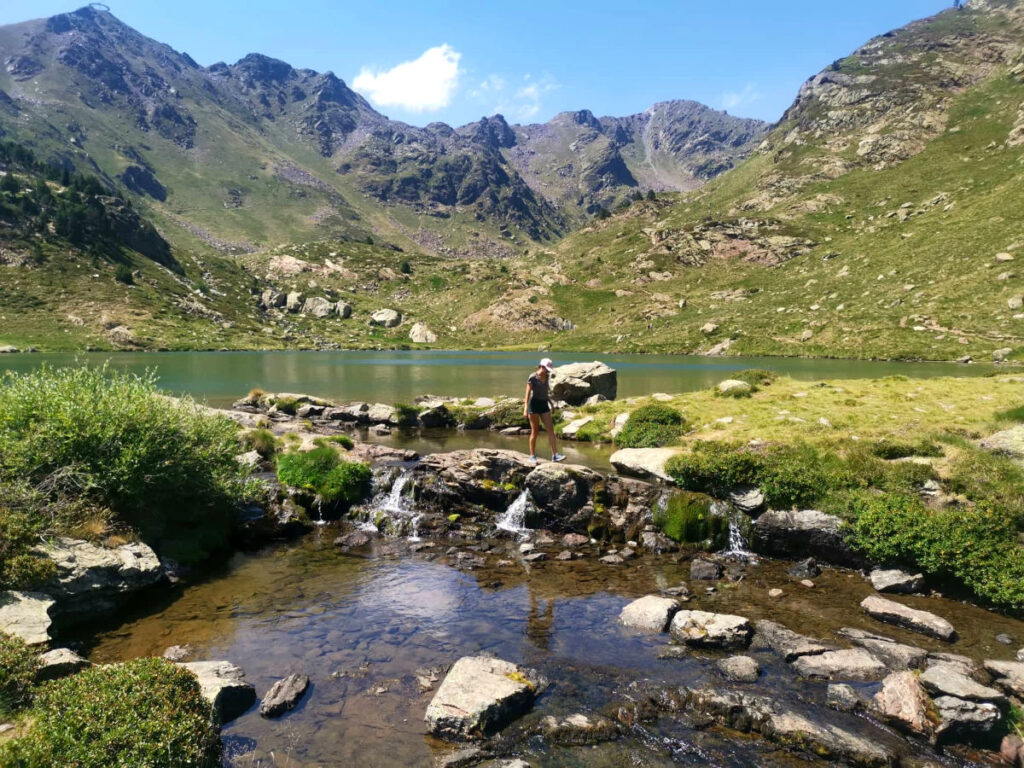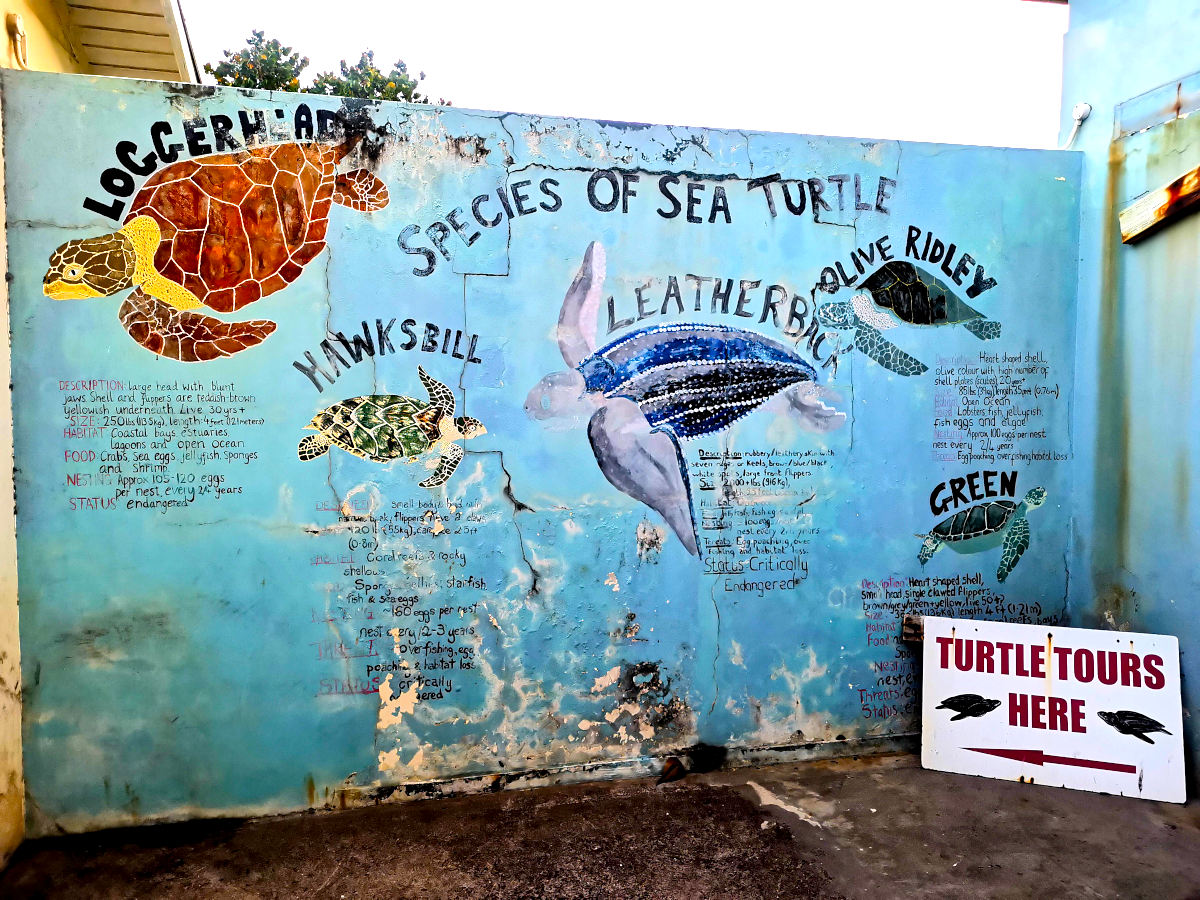
Leatherback Turtles Grenada – A Unique Wildlife Experience
There are several species of turtles Grenada hosts in its waters. But the most famous is the leatherback turtles that lay their eggs on the shores of Levera Beach north of the island.
We stayed in Grenada for 6 months housesitting at Bathway Beach which is walking distance from Levera Beach. Going on a tour to see them ended up being one of the highlights of our stay.
If you are in Grenada from April – July and interested in wildlife you should definitely consider seeing them. The sheer size of them is mind-blowing and it is an experience you will never forget.
So let’s find out all you need to know about seeing some amazing turtles in Grenada! 🐢
Where can I see turtles in Grenada?
There are several species of turtles that make their homes in the water of Grenada. The Grenada sea turtles include the Leatherback, Loggerhead, Green, and Hawkbill turtles.
If you go snorkeling it is possible that you will see one of them in the waters around Grenada. Particularly if you go snorkeling around Carriacou which is a popular activity.
But the most amazing turtle experience in Grenada is to see the Leatherback Turtles. To do this you will have to go on a tour to Levera Beach which is in the north of Grenada.
Read also: These are the 7 best beaches in Grenada 🏖️

Where and when do turtles lay their eggs in Grenada?
In Grenada Leatherback Turtles almost exclusively lay their eggs at Levera Beach. Because Leatherback Turtles are endangered the government has created the Levera National Park, Grenada.
It is only a tiny National Park so do not expect a huge wilderness area. But it is very important to protect the Leatherback turtles nesting area. From April until July, the turtles arrive at the beach at night to lay their eggs.
During this time period, members of the public can’t go to the beach between 6 pm and 6 am without a guide. There is security at the beach all night. So to see the turtles you will have to go on a tour.
Read also: How to see Grenada’s Underwater Sculpture Park 🐠
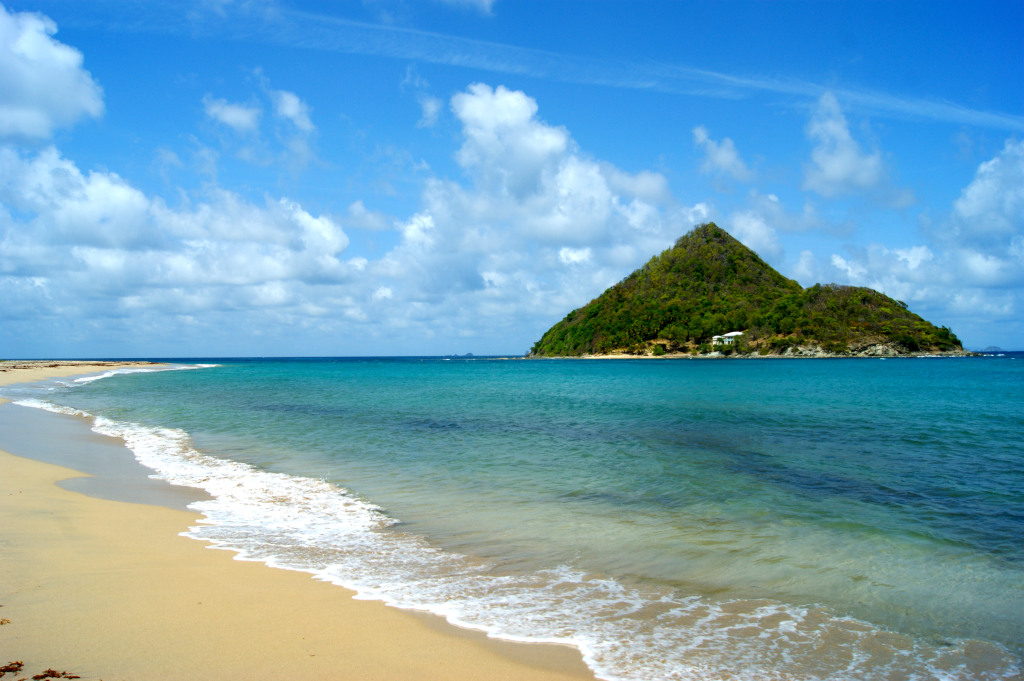
Leatherback Turtles Nesting Season in Grenada
Leatherback Turtles arrive at Levera Beach between April and July at night to lay their eggs. Each nesting female can lay eggs 4-7 times per season.
Each time they can lay around 120 eggs! So there are thousands of eggs buried in the sand each year.
Sadly only 1 in 1,000 turtles that hatch eventually grow up to be adult turtles. This is because most are eaten by predators such as birds and fish while they are still young 😪
That is why it is extremely important that the nesting areas are protected. Because the turtles need to lay thousands of eggs in order for the population to remain stable.
Unfortunately all around the Caribbean locals used to eat the eggs of Leatherback Turtles. This caused the number of turtles to decrease drastically. But in recent years locals have recognised the importance of the turtles and have started protecting them.
Going on a tour is a great way to ensure the survival of the turtles. It brings money into locals’ hands and will hopefully persuade more people not to eat the eggs.
Read also: 20 unique things to do in Grenada ✨
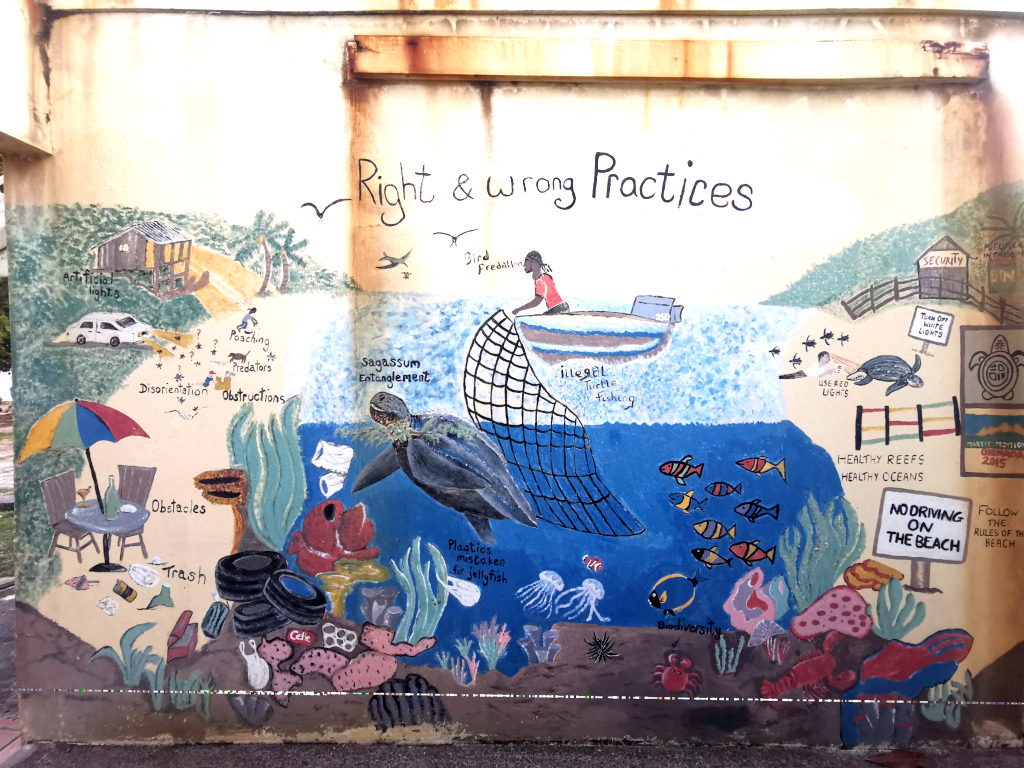
Why are they called Leatherback Turtles?
They are called Leatherback turtles because they have a soft shell that feels like leather. The reason for the soft shells is that Leatherback turtles dive very deep in the ocean, up to 1,200m (4,000 ft) deep!
If they had a hard shell like other turtles their shell would crack under the pressure this far down.
It is a bit of a mystery why Leatherback turtles dive this far down. Because they feed primarily on jellyfish which are only found close to the ocean surface.
One theory is that by diving this deep the turtles can kill any parasites that are living on them because they can’t survive the pressure in extreme depths.
Fascinating Leatherback Turtle Facts
1. Leatherback turtles have existed in relatively the same form for around 100 million years
2. The population of nesting females is between 34,000 to 36,000
3. They can be found over a huge area of ocean from Southern Africa to Nothern Alaska and the Caribbean – wow!
4. They are the largest sea turtle in the world and have an average weight of 384kg (846lbs)
5. The largest Leatherback recorded was 305cm (10ft) long and weighed 916kg (2019lbs)
6. The front flippers can grow up to 2.7m (9ft) long
7. They have a max swimming speed of 35km/h (21 miles)
8. Primary feed on jellyfish which makes them particularly vulnerable to plastic pollution as they can inhale plastic bags accidentally
Leatherback Turtles Tours Grenada
In order to see Leatherback turtles nesting in Grenada you will have to:
- Go on a tour with SPECTO or
- Volunteer with Ocean Spirits Grenada
There is no other legal way to see the turtles and also only one licensed tour and volunteer operator. So make sure to book with them to protect the turtles.
The tours and volunteering only take place at night because that’s when the Leatherback turtles go on shore to lay their eggs.
The licensed organization that conducts the tours is called SPECTO. It is a local non-profit that is committed to protecting the leatherback turtles and the local environment.
So the money you pay for the tour is going to a good cause, same if you choose to volunteer.
How to book the tour:
– The tour costs 80 EC (30 USD) p.p. which must be booked at least 2 days in advance
– You can either email specto.grenada@gmail.com or call +1 473 405 8395
– You need to let SPECTO know the number of people, what date, and your contact info
– Every tour starts at 6 pm daily between April – July and goes up to midnight
– You pay in cash on arrival
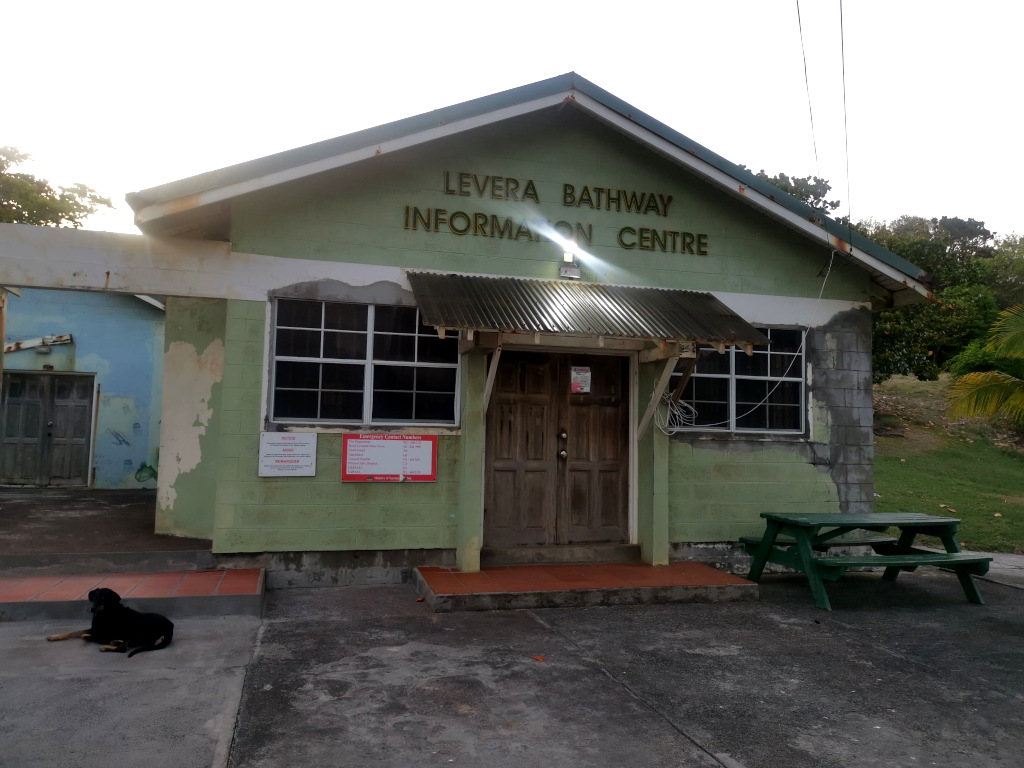
What to Expect on your Leatherback Turtle Tour
After you have booked your tour you will need to arrive at the Levera Bathway Information Center at 6 pm. The guides will meet you and the others in your group at the center.
You will need to pay for your tour here in cash, so make sure you have some on you. After that, the guides will give a 10-minute introduction about the turtles of Grenada and what to expect on the tour.

Important things to know
1. You cannot use white flashlights as it disturbs the turtles. You can only use red lights
2. There is no guarantee you will see turtles. If no turtles arrive by 11 pm then the tour is over but you will have the chance to come back on another day for free
3. You cannot walk around the beach looking for turtles. You will have to wait at the entrance to the beach with your SPECTO guide until volunteers from Ocean Spirits spot a turtle. When they spot one they will tell your guide who will bring you to the turtle
After the introduction, you will follow the guides in your car to Levera Beach. It is a quick 5-minute drive from the Information Center at Bathway to Levera Beach.
There are some picnic benches at the Levera Beach car park you can sit on while you wait for a turtle to arrive. How long you have to wait is totally up to chance.
Waiting for a turtle to arrive is very exciting. You are sitting in silence on the beach listening to the waves while your eyes are getting used to the darkness and watching the stars ✨
Our Experience on the Leatherback Turtle Tour
Luckily when we did our tour we were only sitting on the benches by the beach for about 10 minutes before the volunteers spotted a turtle.
We had prepared ourselves to be waiting at the beach for hours. So we were so excited that a leatherback turtle arrived so early!
Once we knew there was a turtle the SPECTO guides lead us to the location which was about a 20-minute walk along the beach.
When we arrived at the turtle we had to stay about 50 meters (164 ft) away for around 15 minutes. This was because the volunteers noticed that the turtle was acting nervous so they didn’t want people to come too close to it.
Even from a distance, we could see that the turtle was huge! But it wasn’t until we got up close that we really appreciated how massive it was.
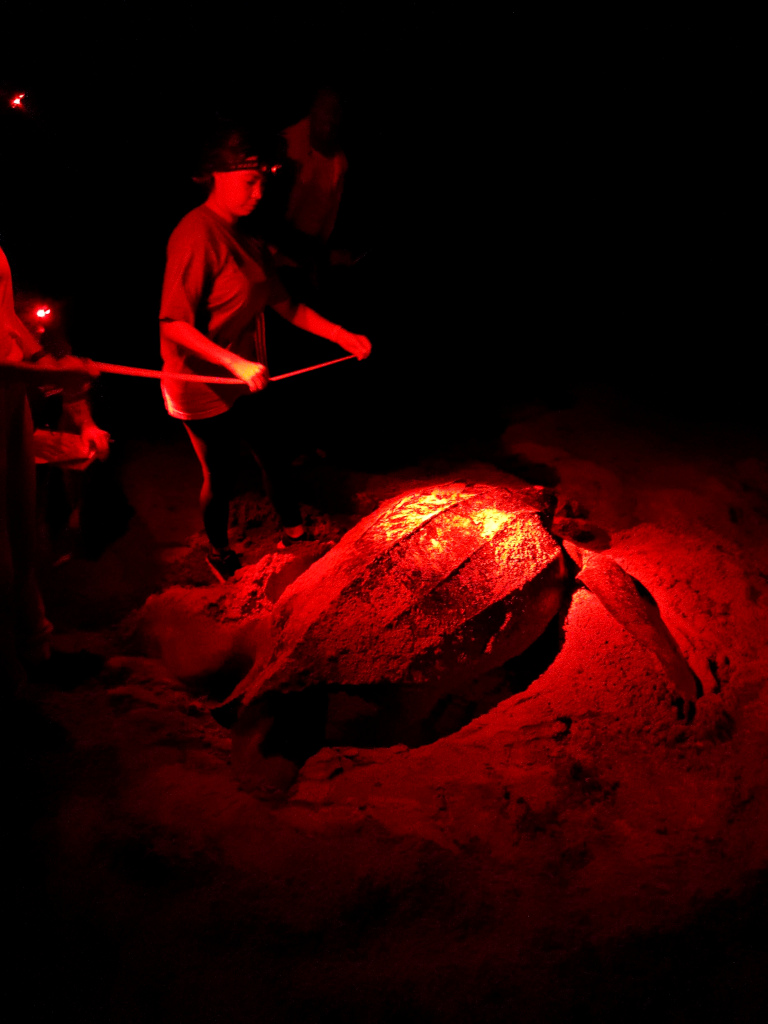
Getting up close to the Leatherback Turtle
Once the turtle had calmed down we were allowed closer. When you are up close the turtle’s flippers and overall size are impressive.
It is also incredible to see the depth of the hole the turtle is able to dig with its back flippers. In the picture above the turtle is busy digging its hole.
The turtle that we saw on the beach was 1.8 meters (6 feet) long and looked like it weighed a few hundred kgs or pounds. It looks even bigger in real life than in the pictures.
Once the leatherback turtle starts laying its eggs it goes into a trance and you are able to get very close without disturbing it.
The guides will even allow you to touch the turtle. I felt a bit weird about touching a wild turtle while it was laying its eggs so I decided not to.
But it is up to each individual whether you decide to. If you decide to you will be able to feel the turtle’s leathery shell.
The Nesting Process
The guides will explain the nesting process of the turtles which is quite a long process and can take up to 3 hours. That’s why the turtles only nest at night.
1. First, the turtle must find a spot where it feels safe to lays its eggs
2. Once it has found a sport it will start digging a hole with its rear flippers (this process is incredible to watch because it can dig quite a deep hole with its flippers)
3. Then it will start laying its eggs that the Ocean Spirits volunteers will count
On the night of our tour, the turtle laid its eggs too close to the high tide mark. So the volunteers collected the eggs and buried them in another location to prevent them from washing away.

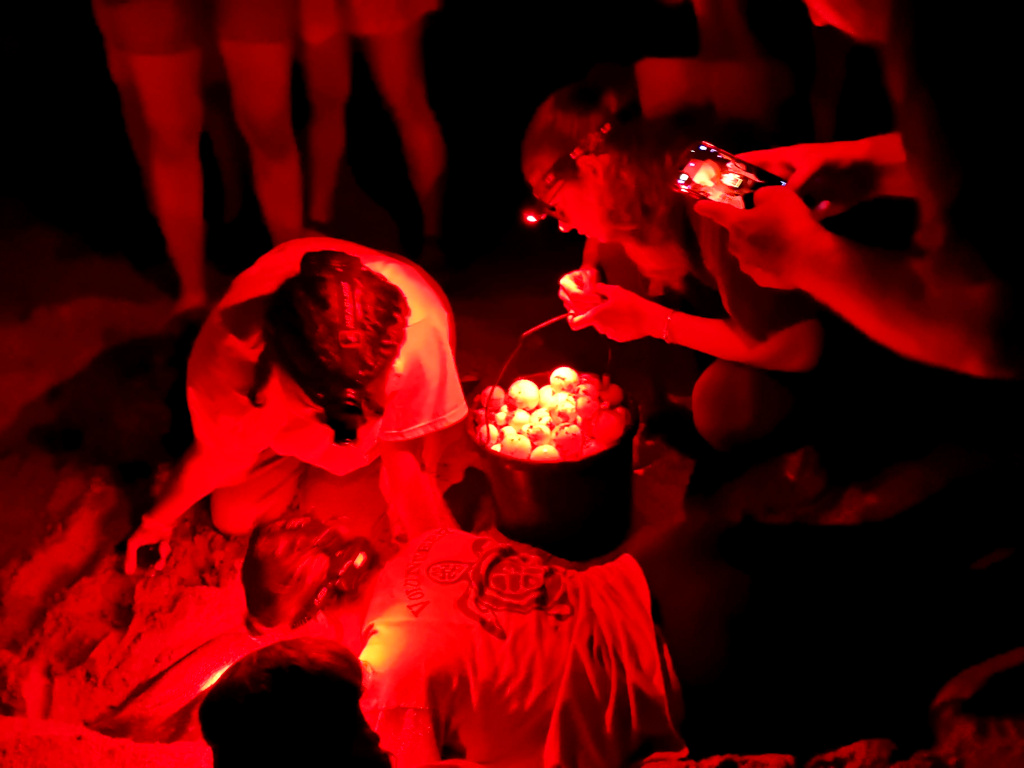
Once the turtle has finished laying its eggs it will camouflage the hole so predators cannot find it. It does this by flicking sand all over the place with its fins.
This was interesting to watch and it was incredible how much sand the turtle could flick around with its fins. You are allowed to stand right next to the turtle during the whole process which is amazing.
Once the turtle has finished camouflaging its hole it will slowly head back to the water and disappear into the waves. The nesting process took around 45 min to an hour and was an awesome experience.
After the turtle has gone back into the ocean you will walk back to your car and the tour is over.
How Long the Tour will Take
We ended up being back in our car ready to head home at around 9:30 pm. But we were very lucky because a turtle arrived as soon as we got to the beach.
So if a turtle arrives later you could end up leaving after midnight. That’s something to keep in mind because most people stay in Grenada’s south which is a long drive away.
But even though there is no guarantee of seeing a turtle and it is in quite an isolated location it is an absolutely incredible experience that is a must-do in Grenada.
Where to Stay for a Turtle Tour
Most accommodation in Grenada is located in the south of the island near its capital St George. So it may be better for you to book a hotel closer to Levera to avoid the 1.5h drive each way.
A great hotel that is a 25-minute drive to Levera Beach is Hotel Petit Anse. It is well-known in the area and has ocean-view rooms, a private beach, and a restaurant.
Even closer by is Bathway Beach, so you can look for accommodation there too. Either on Booking.com or Airbnb. On Levara Beach directly is no accommodation.
Volunteering with Ocean Spirits Grenada
If you are passionate about wildlife then there is an opportunity to volunteer with Ocean Spirits. They are the organization that is directly involved in protecting the Leatherback turtles in Grenada.
You will need to commit for at least 2 weeks and programs start from 1,200 USD. This fee includes accommodation and meals and you will take part in overnight watches on the beach.
Volunteers will have shifts patrolling the beach during the night so you will not have to stay up the whole night. So you will need to be a bit of a night owl!
Find more info on their Working Abroad page 🐢
Now you know all about Grenada’s turtles
Seeing Leatherback turtles lay their eggs is a truly magical experience and one of the coolest natural wonders I have seen. You will leave feeling like you have seen a real-life dinosaur.
I highly recommend booking a tour with SPECTO if you are in Grenada from April – July. If you are looking for more unique things to do in Grenada then check out our other articles below.
READ ALSO
- 7 best beaches in Grenada
- 5 best waterfalls in Grenada
- 20 unique things to do in Grenada
- How to get to Hog Island Grenada
- 6 best chocolate factories in Grenada
Hey there! Some of the links on this page are affiliate links. This means that if you choose to make a purchase we may get a small commission at no extra cost to you. These commissions help us to generate income and keep creating content for you. So we greatly appreciate your support! Thanks!
Hi, I am Allan, a travel, health and fitness fanatic from New Zealand. I'm a former lawyer who turned into a full-time nomad in 2020. For the last 4+ years I've been traveling the world. I'm always on a hunt for good food, activities on a budget and workouts on the go. I hope you find my tips helpful and get inspired to travel more!

